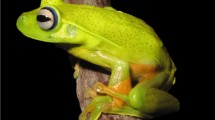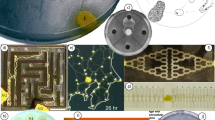Abstract
Behavioral observations made on a group of 15 stumptail macaques living in a seminatural environment are used to delineate an activity profile for the species which embraces numerous locomotor, self-directed, environment-directed and social behaviors. Data indicating that certain animals direct or receive particular behaviors at markedly different rates than the rest of the group are noted. The data from 39,000 10-sec observational samples are used to construct a detailed behavioral time-budget for the group. The budget takes into account the co-occurrence rates of the most frequently observed behaviors with each other and with the other behaviors recorded. The activity profile constructed in this way is compared with the results of four other studies which estimate daily behavioral rates for the species. Environmental, social group composition and sampling-technique variables are considered for their probable effects upon the behavioral rates reported in both the present and the compared studies. A detailed comparison of data from the different studies permits the estimate of a species-typical rate for each of the behavioral patterns reported and commented upon. The estimated rates, expressed as a range of values indicating the percentage of time that an average group member dedicates to various behaviors, should be valid in a wide variety of environments.
Similar content being viewed by others
References
Altmann, J., 1974. Observational study of behavior: Sampling methods.Behaviour, 49: 227–265.
Baldwin, L. A. &G. Teleki, 1976. Patterns of gibbon behavior on Hall's Island, Bermuda—A preliminary ethogram forHylobates lar. In:Gibbon and Siamang, Vol. 4,D. M. Rumbaugh (ed.), S. Karger, Basel & New York, pp. 22–105.
Bernstein, I. S., 1980. Activity patterns in a stumptail macaque group (Macaca arctoides).Folia Primatol., 33: 20–45.
Bertrand, M., 1969.The Behavioral Repertoire of the Stumptail Macaque—A Descriptive and Comparative Study. S. Karger, Basel & New York.
Chamove, A. S., 1973. Social behavioral comparison in laboratory—reared Stumptail and Rhesus Macaques.Folia Primatol., 19: 35–40.
Esser, A. H., R. D. Deutsch &M. Wolf, 1979. Social behavior adaptations of gibbons (Hylobates lar) in a controlled environment.Primates, 20: 95–108.
Estep, D. Q., K. E. M. Bruce, M. E. Johnston &T. P. Gordon, 1984. Sexual behavior of grouphoused stumptail macaques (Macaca arctoides): Temporal, demographic and sociosexual relationships.Folia Primatol., 42: 115–126.
Estrada, A. &R. Estrada, 1976a. Birth and breeding cyclicity in an outdoor living stumptail macaque (Macaca arctoides) group.Primates, 17: 225–231.
———— & ————, 1976b. Establishment of a free-ranging colony of stumptail macaques (Macaca arctoides): Relations to the Ecology I.Primates, 17: 337–355.
———— & ————, 1984. Female-infant interactions among free-ranging stumptail macaques (Macaca arctoides).Primates, 25: 48–61.
————, & ————, & F. Ervin, 1977. Establishment of a free-ranging colony of stumptail macaques (Macaca arctoides): Social relations I.Primates, 18: 647–676.
Goldfoot, D. A., H. Westerborg-van Loon, W. Groeneveld &A. Koos Slob, 1980. Behavioral and physiological evidence of sexual climax in the female stump-tail macaque (Macaca arctoides).Science, 208: 1477–1478.
Gouzoules, H., 1974. Harassment of sexual behavior in the stumptail macaque (Macaca arctoides).Folia Primatol., 22: 208–217.
————, 1975. Maternal rank and early social interactions of infant stumptail macaques,Macaca arctoides.Primates, 16: 405–418.
Hendy-Neely, H. &R. J. Rhine, 1977. Social development of stumptail macaques (Macaca arctoides): Momentary touching and other interactions with adult males during the infants' first 60 days of life.Primates, 18: 589–600.
Hinde, R. A. &L. P. Proctor, 1977. Changes in the relationships of captive rhesus monkeys on giving birth.Behaviour, 51: 153–160.
Leger, D. W., 1977. An empirical evaluation of instantaneous and one-zero sampling of chimpanzee behavior.Primates, 18: 387–393.
Lifshitz, K., R. T. O'Keeffe, K. L. Lee &J. Avery, 1984/85. KIBOS: A microcomputerized system for the continuous collection and analysis of behavioral data.Appl. Anim. Behav. Sci., 13: 205–218.
O'Keeffe, R. T., K. Lifshitz &G. Linn, 1982/83. Relationships among dominance, inter-animal spatial proximity and affiliative social behaviour in stumptail macaques (Macaca arctoides).Appl. Anim. Ethol., 9: 331–339.
Rhine, R. J., 1972. Changes in the social structure of two groups of stumptail macaques (Macaca arctoides).Primates, 13: 181–194.
————, 1973. Variation and consistency in the social behavior of two groups of stumptail macaques (Macaca arctoides).Primates, 14: 21–35.
———— &P. B. Ender, 1983. Comparability of methods used in sampling of primate behavior.Amer. J. Primatol., 5: 1–15.
————, &M. Flanigon, 1978. An empirical comparison of one-zero, focal animal and instantaneous methods of sampling spontaneous primate social behavior.Primates, 19: 353–361.
————, &C. Kronenwetter, 1972. Interaction patterns of two newly formed groups of stumptail macaques (Macaca arctoides).Primates, 13: 19–33.
Rowell, T.E., 1967. A quantitative comparison of the behaviour of a wild and a caged baboon group.Anim. Behav., 15: 499–509.
Seyfarth, R. M., 1983. Grooming and social competition in primates. In:Primate Social Relationships—An Integrated Approach, R. A. Hinde (ed.), Signauer Assoc., Inc., Sunderland, Mass., pp. 182–190.
Smith E. O. &L. D. Byrd, 1983. Studying the behavioral effects of drugs in group-living non-human primates. In:Ethopharmacology: Primate Models of Neuropsychiatric Disorders, Alan R. Liss, Inc., New York, pp. 1–31.
Trollope, J. &N. G. Blurton-Jones, 1975. Aspects of reproduction and reproductive behaviour inMacaca arctoides.Primates, 16: 191–205.
Weisbard, C. &R. W. Goy, 1976. Effect of parturition and group composition on competitive drinking order in stumptail macaques (Macaca arctoides),Folia Primatol., 25: 95–121.
Author information
Authors and Affiliations
About this article
Cite this article
O'Keeffe, R.T., Lifshitz, K. A behavioral profile for stumptail macaques (Macaca arctoides). Primates 26, 143–160 (1985). https://doi.org/10.1007/BF02382014
Received:
Accepted:
Issue Date:
DOI: https://doi.org/10.1007/BF02382014




